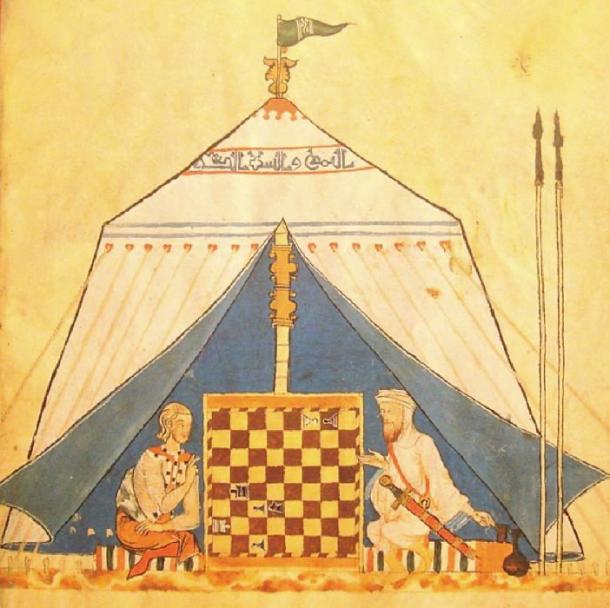
Is This The Oldest Chess Piece In The World?
Archaeologists digging in Jordan may have found the oldest chess piece in the world.
John Oleson, an archaeologist at the University of Victoria in British Columbia, Canada, believes he and his colleagues may have found “a rook”, which in the game of chess can move as many spaces as it can in any one direction. But this particular ancient sandstone rook didn’t move anywhere for 1300 years, rather, it lay in the sand below an ancient 7th century trading post in Jordan.
The carved sandstone was found at a site called Humayma, located along a once-prominent trading route in southern Jordan linking India to the Near East and Middle East. Also present at this site are stone tombs dating to the first century, a ruined Roman fort, Byzantine churches and early Islamic mosques.
Rooks Were Once Horse-Drawn Chariots
With its rectangular body and two curved horn-like protrusions on top, the sandstone figure was excavated from the ruins of a 1,300 years old Islamic settlement in 1991, and alternately to the mini-crenellated castle towers we are familiar with it is thought to represent a horse-drawn chariot.

Carved rock believed to be a horned rook from 1300 years ago. (Image: © John Peter Oleson)
In an abstract published by the American Schools of Oriental Research 2019 (ASOR), Oleson explains that chess was popular throughout the Islamic world and that the word “rook” comes from the word “rukh,” which is the Persian word for chariot, and that there are references to chess-playing in Islamic texts as early as AD 643. And if this tiny sandstone figurine is proven to be a rook from a chess game, according to Oleson, it’s the single “oldest chess piece ever discovered”.

A Christian and Muslim playing chess (painting circa 1251 and 1283). (Public Domain)
The Oldest Chess Piece, Or A Rookie Error?
Oleson addressed ASOR at a meeting in San Diego last week where, according to Live Science, he said the game probably was “carried westward from India by the movement of merchants and diplomats”, and it is no surprise to the doctor that evidence of the game should be found located on a busy trade route like the one where it was found.
According to Oleson, Humayma was inhabited by the powerful Abbasid family who declared themselves “caliphs” (Islamic rulers claiming succession from the Prophet Muhammad) and it is known that the Abbasid family traded with Syria and Iraq, and Oleson thinks it is plausible that they may have been early adopters of chess.
Concerning “how” the archaeologists know this lump of shaped sandstone was a chess piece, the Live Science report features a 12th century Iranian chess set in which the stone rooks each feature “two pointed horns” representing horse-drawn chariots and they are “nearly identical” to the figurine discovered at Humayma.
Even with this visual match it's impossible to be sure that the twin-horned figure is a rook. However, Oleson says “it's the likeliest explanation”, considering where it was excavated. If the sandstone piece turns out “not” to be a chess piece after all, then Oleson has to admit that he made a bit of a rookie error.
- THE ICELANDIC THEORY: EXPERTS CHALLENGE ESTABLISHMENT DOGMA TO REVEAL HISTORY OF IVORY VIKINGS
- REDISCOVERED VIKING-ERA LEWIS CHESSMAN IS PREDICTED TO MAKE A FAMILY MILLIONAIRES
- A JOTUNN DID NOT HAVE TO BE GIANT TO BE A BIG PROBLEM FOR NORSE GODS
A Big Cheque, For A Tiny Check Mate
And talking about “rookie” chess errors, it was only in July this year a 900-year-old Viking chess piece purchased for $6 in the 1960s sold at auction in July this year for a staggering £735,000.
Created in the 12th century, the 93 Lewis Chessmen are lumps of walrus ivory crafted into little Norse warriors discovered in 1831 on the Isle of Lewis in the Outer Hebrides, Scotland. In June 2019, Sotheby’s announced it had authenticated a missing “rook” that had been bought in 1964 by an antique dealer in Edinburgh and passed down through this family.
According to The Guardian, a family member said it had been stored away in their grandfather’s house, with everyone unaware of its importance and a family spokesperson said “My mother was very fond of the chessman as she admired its intricacy and quirkiness. She believed that it was special and thought perhaps it could even have had some magical significance”. Whether this rook was magic or not, it sold in July for £735,000 which makes one wonder - how much would this newly discovered “oldest chess piece in the world” be worth?
Top image: Arch at Humayma, Jordan (insert, claimed oldest chess piece) Source: Bashar Tabbah /CC BY-SA 4.0; Insert, © John Peter Oleson
By Ashley Cowie
















Comments
I loved this article, I love chess!
Mary Madeline